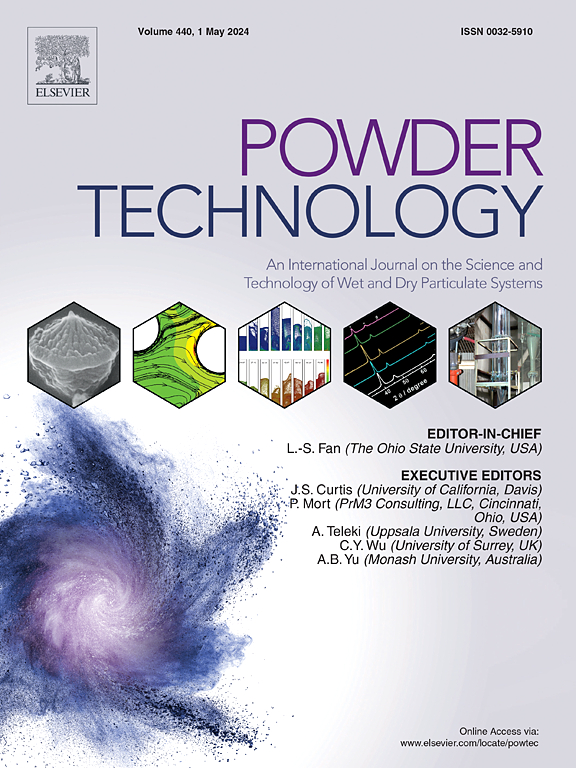研究铝镁锂粉末在等截面燃烧室中的动态燃烧特性:实验研究
IF 4.5
2区 工程技术
Q2 ENGINEERING, CHEMICAL
引用次数: 0
摘要
鉴于粉末冲压发动机技术在高超声速飞行器上的应用前景广阔,金属粉末燃料因其高能量密度而引起了人们极大的研究兴趣。其中,铝基金属粉末作为一种潜在的燃料选择尤其引人注目,具有重要的应用前景。因此,研究铝基粉末的燃烧特性是至关重要的。在本研究中,我们利用旋流燃烧系统在等截面燃烧室中对四种不同粒径分布的Al-Mg-Li粉末进行了实验燃烧研究。结果表明,Al-Mg-Li粉末的粒度分布对燃烧效率有显著影响。粒径在75 μm以下的粉末可以更快地完全燃烧。此外,45 μm以下颗粒的燃烧室出口火焰轮廓更平滑、更连续,表明燃烧效率更高。不同尺寸的扰流锥通过影响Al-Mg-Li粉末的速度、加热时间和浓度分布来影响燃烧火焰的强度。此外,当锥筒位置靠近燃烧室底部(80 mm)时,Al-Mg-Li粉末的燃烧强度和效率都有所提高。最后,在冷空气注入条件下观察到Al-Mg-Li粉末的自燃,重燃脉冲周期为0.7 ~ 0.8 s。本文章由计算机程序翻译,如有差异,请以英文原文为准。

Investigating the dynamic combustion characteristics of Al-Mg-Li powders in equal cross-section combustion chamber: An experimental study
Given the promising applications of powder ramjet engine technology in hypersonic vehicles, metal powder fuels have garnered significant research interest due to their high energy density. Among these, Al-based metal powder is particularly notable as a potential fuel option with important application prospects. Consequently, investigating the combustion properties of Al-based powder is crucial. In this study, we conducted experimental combustion studies on Al-Mg-Li powders with four different particle size distributions using a cyclone combustion system in an equal cross-section combustion chamber. The results demonstrated a significant effect of particle size distribution on the combustion efficiency of Al-Mg-Li powders. Powders with particle sizes below 75 μm achieve full combustion more rapidly. Additionally, the flame profile at the chamber exit is smoother and more continuous for particles below 45 μm, indicating higher combustion efficiency. The varying sizes of the spoiler cone influence combustion flame intensity by affecting the velocity, heating time, and concentration distribution of the Al-Mg-Li powders. Furthermore, when the cone is positioned closer to the bottom of the combustion chamber (80 mm), both the combustion intensity and efficiency of the Al-Mg-Li powders were improved. Finally, under cold air inflow conditions, self-sustained combustion of Al-Mg-Li powders was observed, with a re-ignition pulse period of 0.7–0.8 s.
求助全文
通过发布文献求助,成功后即可免费获取论文全文。
去求助
来源期刊

Powder Technology
工程技术-工程:化工
CiteScore
9.90
自引率
15.40%
发文量
1047
审稿时长
46 days
期刊介绍:
Powder Technology is an International Journal on the Science and Technology of Wet and Dry Particulate Systems. Powder Technology publishes papers on all aspects of the formation of particles and their characterisation and on the study of systems containing particulate solids. No limitation is imposed on the size of the particles, which may range from nanometre scale, as in pigments or aerosols, to that of mined or quarried materials. The following list of topics is not intended to be comprehensive, but rather to indicate typical subjects which fall within the scope of the journal's interests:
Formation and synthesis of particles by precipitation and other methods.
Modification of particles by agglomeration, coating, comminution and attrition.
Characterisation of the size, shape, surface area, pore structure and strength of particles and agglomerates (including the origins and effects of inter particle forces).
Packing, failure, flow and permeability of assemblies of particles.
Particle-particle interactions and suspension rheology.
Handling and processing operations such as slurry flow, fluidization, pneumatic conveying.
Interactions between particles and their environment, including delivery of particulate products to the body.
Applications of particle technology in production of pharmaceuticals, chemicals, foods, pigments, structural, and functional materials and in environmental and energy related matters.
For materials-oriented contributions we are looking for articles revealing the effect of particle/powder characteristics (size, morphology and composition, in that order) on material performance or functionality and, ideally, comparison to any industrial standard.
 求助内容:
求助内容: 应助结果提醒方式:
应助结果提醒方式:


